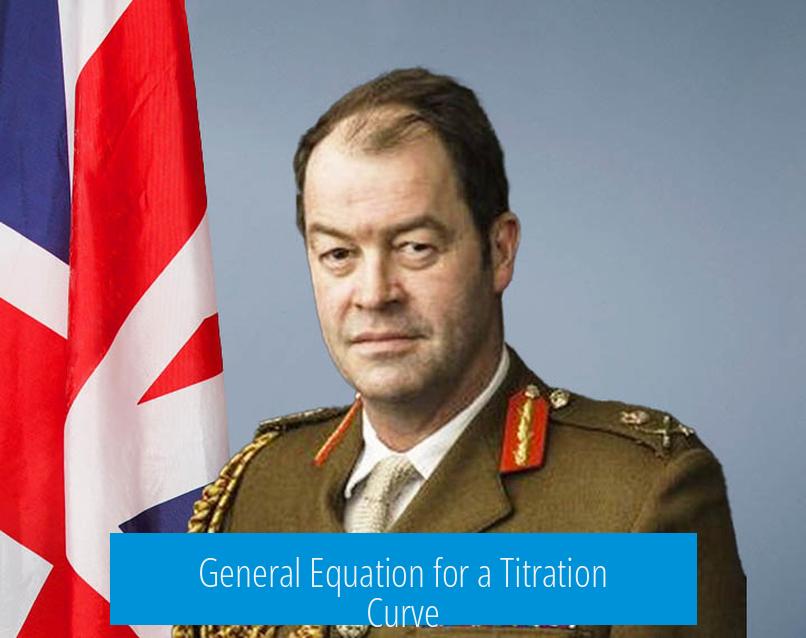General Equation for a Titration Curve

The general equation for a titration curve does not exist as a simple explicit function for pH versus titrant volume. Instead, the relationship is typically expressed implicitly by chemical equilibrium and mass balance equations, often resulting in high-order polynomials that are difficult to invert analytically. Commonly, one solves for titrant volume as a function of pH or models segments of the curve approximately with equations like the Henderson-Hasselbalch equation for buffer regions.
Nature of Titration Curves

Titration curves usually show the change in pH as a titrant is added. For a strong acid-strong base system, the curve resembles a sigmoid (S-shaped) function. The gradual change before and after the equivalence point creates this shape. However, this shape is qualitative rather than strictly defined by one formula.
Limitations of a Single Equation
No single explicit equation expresses pH directly as a function of volume of added titrant for all stages of titration. The complexity arises from the nonlinear chemical equilibria involved. Instead, the volume of titrant required to reach a certain pH can be calculated, forming an implicit relationship.
Approach Using Chemical Equilibria and Polynomials
- Construct mass balance and charge balance equations based on system components.
- Combine these to form polynomial equations in terms of hydrogen ion concentration.
- For simple systems (e.g., HCl and NaOH), resulting polynomials are typically third order.
- These rational polynomials cannot be inverted analytically to isolate pH as a function of titrant volume.
Practical Solutions
Computational methods solve these polynomials for titrant volume as a function of pH. Software such as Mathematica can handle the algebra and provide numerical solutions. The results can then be used to plot titration curves accurately, including more complex systems like polyprotic acids.
Approximate Models: Henderson-Hasselbalch Equation
In buffer regions, the Henderson-Hasselbalch equation offers a useful approximate relation:
pH = pKa + log([A−]/[HA])
This models how pH changes with the ratio of conjugate base to acid, providing a simpler formula for partial curves rather than the full titration.
Sigmoid-Like Functions
Some research experiments with sigmoid functions like the hyperbolic tangent (tanh) to fit titration data, due to their S-shaped curve. Still, these are not established as general equations for titration curves.
Dependence on System and Concentrations
The exact titration curve equation depends on:
- Type of acid and base
- Species involved (strong vs. weak)
- Concentrations and ionic strength
- Reaction equilibria constants
This variability means no universal polynomial or explicit formula can represent all titrations globally.
Key Takeaways
- No simple explicit equation exists for pH as a function of titrant volume for complete titration curves.
- Chemical equilibria lead to high-order polynomials that are difficult to invert analytically.
- Computational methods typically solve for titrant volume as dependent on pH.
- Henderson-Hasselbalch equation approximates buffer regions effectively.
- Curve shape and equations depend on the system’s chemical nature and concentrations.
- Sigmoid functions resemble titration curves but lack formal role as general equations.
What is the general shape of a titration curve for strong acid-strong base titrations?
It typically resembles a sigmoid, or S-shaped, curve. This shows a gradual pH change followed by a sharp rise near the equivalence point.
Why can’t pH be expressed as a simple function of titrant volume for all titration stages?
No single equation accurately describes pH over the entire titration. Instead, the volume of titrant needed is often treated as a function of pH.
How do balance equations contribute to the titration curve equation?
Setting up balance and equilibrium equations leads to a third-order rational polynomial. This polynomial generally cannot be solved algebraically for pH as a function of titrant volume.
What is a practical way to model the titration curve using equations?
It’s easier to solve for the volume of titrant as a function of pH. Using software like Mathematica or Excel, you can generate titration curves from these solutions.
Can the Henderson-Hasselbalch equation be used for titration curves?
Yes, especially for buffer systems. It approximates pH changes during acid-base titrations but is less precise for strong acid-strong base systems.
Is the hyperbolic tangent (tanh) function used to model titration curves?
While tanh resembles the shape of titration curves, it is not formally used or widely documented for modeling titrations.





Leave a Comment